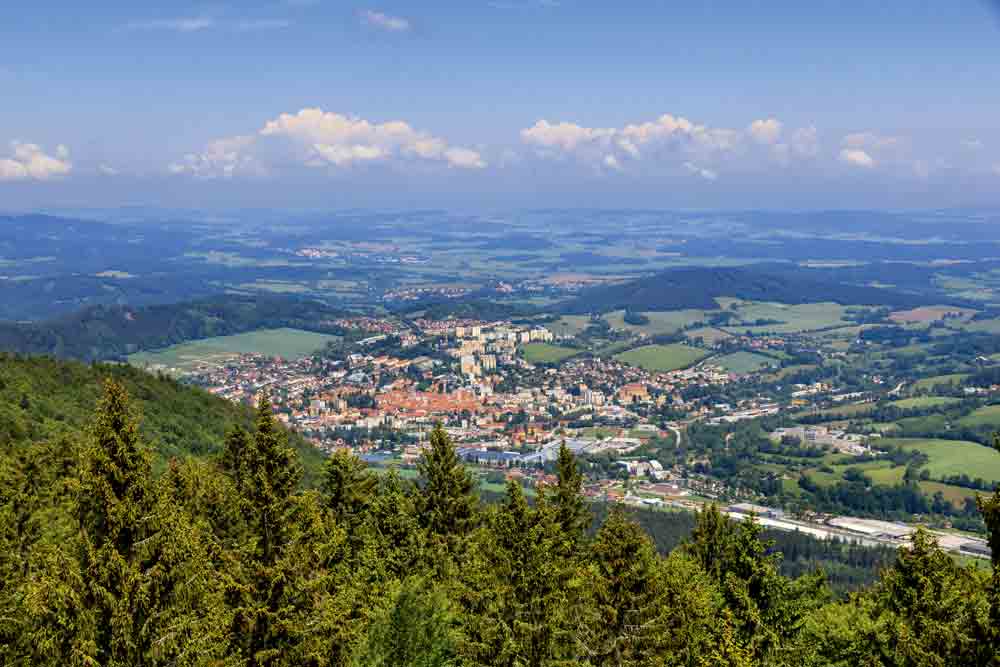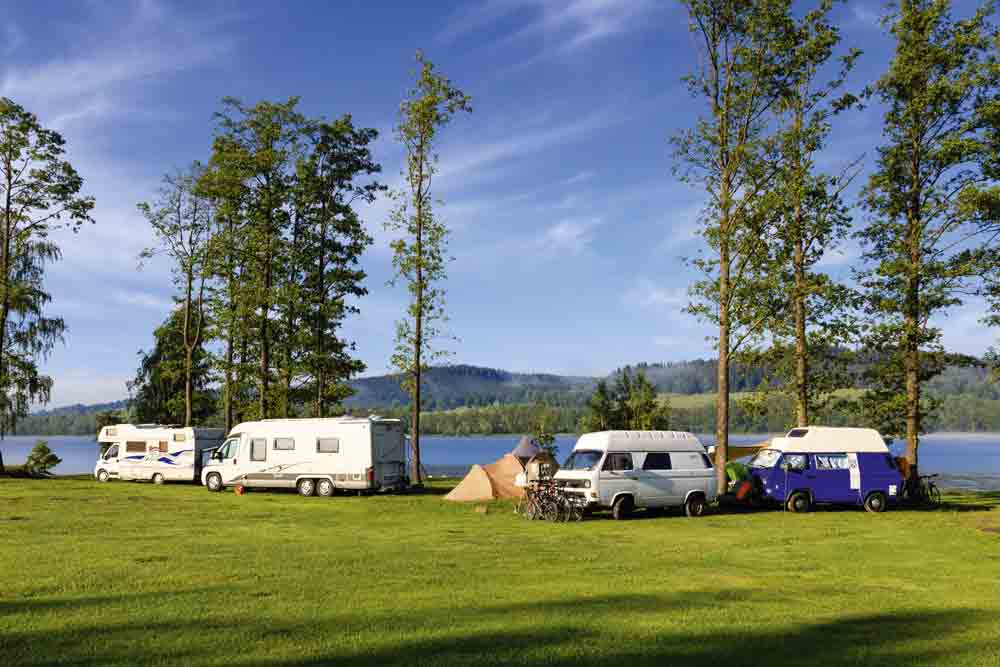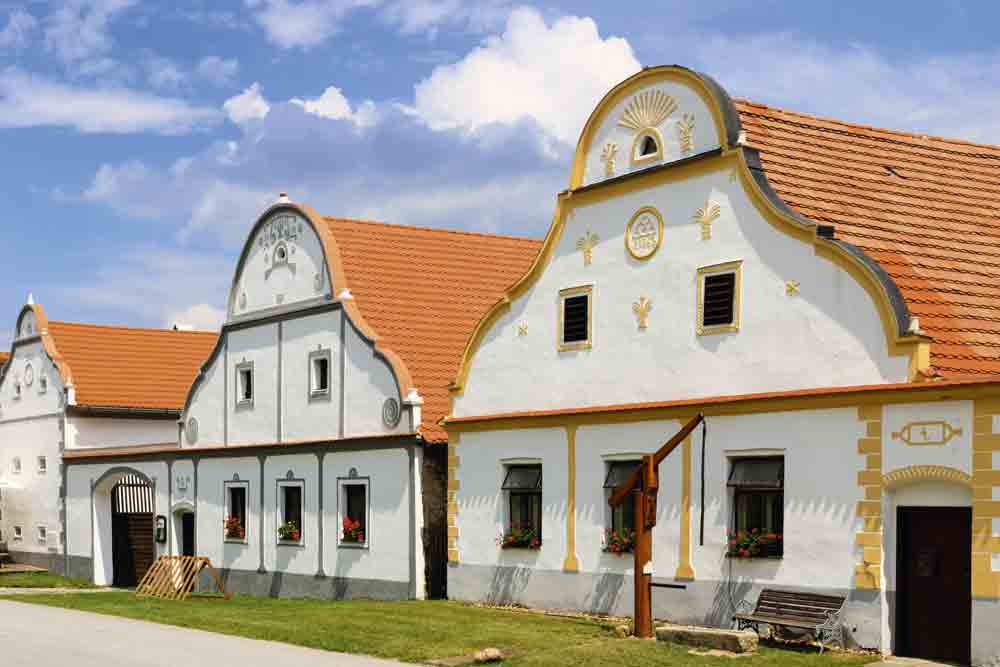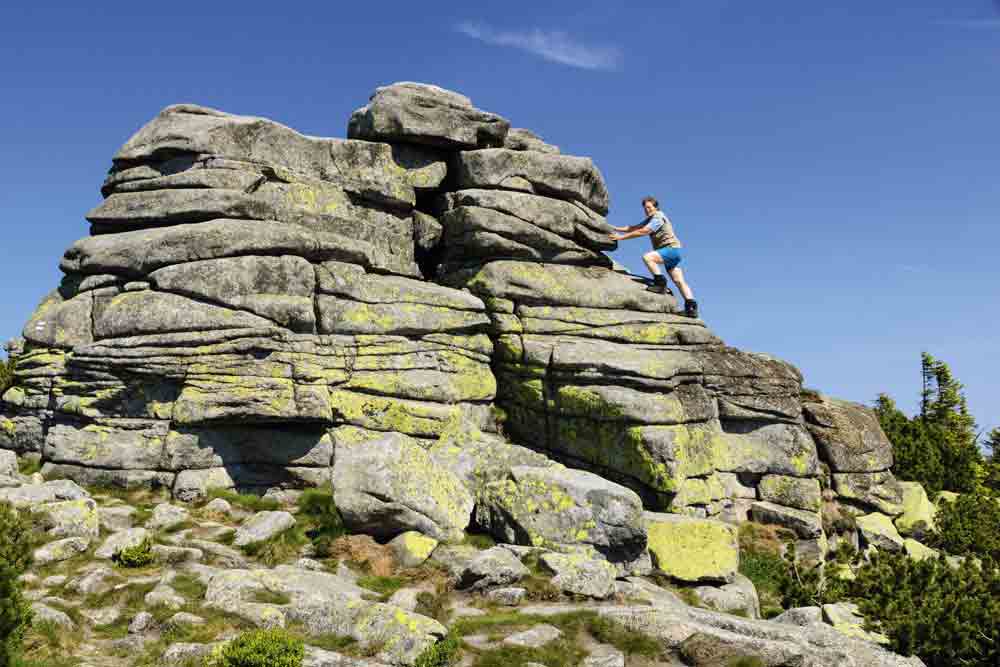Motorhome travel: Touring the Czech Republic
Words and photos by Felicity Martin
Andrew and I enter the Czech Republic knowing as many words of the Czech language as our collie, Braan. Although we’ve been told that English isn’t widely spoken, we hope to get by with goodwill, sign language and the Google Translate app.
We received many recommendations of places to visit from Markéta, the Czech partner of Andrew’s brother. They look wonderful in the photos she has sent, but we’d probably need a month, not a week, to visit them all.
Coming through Germany the weather has been very hot with thunderstorms late in the day. In the Czech Republic – or Czechia to the locals – the thunderstorms cease, but it remains unseasonably hot for May, reaching 30°C most days and staying warm all night. Seeking cool shade, we head into the forests and Šumava National Park and follow brown signs to a small car park at the start of walking and cycling routes.
We take a walk through the adjacent wetland on one of the circuits shown on a map board. A cirl bunting – a bird first for me – flits in and out of a bushy willow beside us and a red-backed shrike makes sorties overhead. Male corncrakes call with creaky double croaks from the thigh-high grassland full of buttercups, forget-me-not, speedwell, red clover, bistort, cow parsley and many other wildflowers.
The medieval town of Prachatice

According to a friend of Markéta’s, nearby Libín Tower has ‘the best view in the world’ and Prachatice, where he lives, is a lovely medieval town. We drive to the nearest forest car park and enjoy a stroll up to the tower. The trail passes through some natural woodland regeneration that is full of butterflies and wildflowers. Because the Czech foresters only fell small patches of trees at a time they don’t need to replant and simply allow new saplings to germinate from the adjacent seed sources. It all looks much more natural than British forestry.
At the top, we climb steps within the tall column of Libín Tower. Above the treetops, a wonderful view stretches all round, with panels in four directions showing the distant hills, several above 1,300m (4,265ft).
Prachatice doesn’t disappoint, either. At its centre is a big cobbled square with a fountain, surrounded by grand buildings decorated with wall paintings. We sit under a parasol in a pavement restaurant overlooking the square and enjoy a super lunch. I have pork escalopes with ham and blue cheese, Andrew has woodcutter’s steak with fried onions and we also order french fries and grilled mixed vegetables, plus bottled water. The price is very reasonable at 530CZK in total (£19.17).
For the next two nights we stay at Kemp u Kukacku on the shores of Lipno lake, a large reservoir that is a popular holiday location for Czechs – the nearest they have to ‘seaside’. The campsite reception is in a very modern building with a bar/restaurant and offers the hire of watersports equipment. The new showers require tokens and have a display of red LEDs that indicate how much time you have remaining.

While filling Stella with water I hear a black redstart scolding from a perch nearby and discover that a newly fledged chick has flown into the motorhome and is flapping around on the dashboard. Fortunately it soon escapes and flies off, unsuccessfully trying to land on the curved roof of a caravan before it finds a secure perch.
A day in historic Ceský Krumlov
In the morning we are engulfed in lake mist, but I soon see blue out of the skylight as it burns off, promising another hot, sunny day. We are going to spend it in Ceský Krumlov, a historic and picturesque town about 25 miles away, travelling by rail so we can enjoy the scenery.
The nearest station, at Horní Planá, is only just over a mile away by a good cycle path, which we cruise along with Braan trotting beside us. The train journey takes us through a wonderfully rustic landscape of small farms, pretty streams and inviting woods; we see roe deer and a family of wild boar bounding away as the train passes.
Ceský Krumlov has an outstanding location on an almost circular loop of river with an imposing castle on the cliff above. The best viewpoint is the castle tower, rising high above the red-roofed buildings. Dogs aren’t allowed in, so Andrew takes Braan down to the river for a cooling swim while I visit the castle museum and tower.
Ever narrower flights of steps take me high above the town for a breathtaking view. I’m fascinated by the streams of canoes and rafts coming down the curving river; apparently a popular way to view the town.
The museum contains paintings, weapons, military instruments and domestic furnishings relating the castle’s history. Its room of religious relics includes a macabre exhibit: a glass box containing St Reparat’s mummified body encrusted in jewellery.
It’s quite difficult to walk the streets of the town because it is thronging with tourists, with many large groups being led by guides holding numbered signs above their heads. Built in the 1500s, it is picturesque and well preserved, but we are relieved at the end of the day to escape the crowds and return to the shores of Lipno.
We’d planned to spend the next two nights in Prague near the botanical gardens at Camping Troja but, after the hordes of tourists in Ceský Krumlov, neither of us fancies traipsing around a hot, bustling city, however magnificent the architecture.
For us relaxation and pleasure are found in wildflower meadows, shady woods and lofty hills. So we decide instead to seek out the greener parts of the country where the Czechs go on holiday.
Over the next days we traverse the country from the southwest to the northeast, first visiting Holašovice, in quiet countryside west of Ceský Krumlov. The village is a UNESCO world heritage site because it is the best preserved of some 50 such villages with decorative houses arranged, gable end on, around a central green. They are in the South Bohemian Baroque style and, although built in 1840-50, follow a medieval ground plan. The houses are all privately owned and lived in, but one has a small museum.

After I’ve taken photos I find Andrew there, deep in conversation with the owner, Vlasta, whose family has been here 500 years. His sheds are full of ancient farm and woodworking equipment and they are discussing the uses of each tool. I’d noticed hand pumps outside the houses and, apparently, water was brought to the village using hollowed-out spruce trunks as pipes.
We stay overnight at a quiet and remote camperstop at Farma Alpaka in hills north of Nová Bystrice. Tomáš and Jana only have two alpacas – the farm mascots – but they do breed Irish cobs and keep ponies and a few goats. They make us feel at home and we have free run of the pastures and copses.
The next day we visit another UNESCO site: the silver mines at Kutná Hora, which made it the ‘Treasury of the Kingdom’. These riches created a town full of fabulously grand buildings, including Cathedral of St Barbara, a soaring gothic edifice. We approach it by a terrace where carved stone statues rise above the balustrade every few paces.
We buy 1kg each of apricots and strawberries from a stall in the square. Because we’re taking advantage of local seasonal produce, most of our meals seem to include asparagus and strawberries!
A Bohemian Paradise
Our next destination is the ‘Bohemian Paradise’, a romantic wilderness of rock spires, ruined castles and châteaux that has attracted artists and tourists for two centuries. As we approach our campsite we have a wonderful view of Trosky Castle. With its ruins perched on twin basalt pinnacles rising above the surrounding forest, it could be a scene from a fairy tale.
At Camp Sedmihorky we chose a pitch with a view to Hruboskalsko, where clusters of eroded sandstone pillars, up to 60m (197ft) high, protrude above the trees like strange statues. It’s a very family-friendly place with children and teenagers playing volleyball and swimming in the small lake.
In the morning we walk out of the back of the campsite onto paths that weave around the towering rocks, sometimes climbing and descending staircases or squeezing through narrow gaps. We go as far as Valdštejn Castle, set on top of cliffs and accessed by a stone bridge. Built in 1260, it is a paying attraction and doesn’t allow dogs in. Instead we enjoy coffee and apple pastries in an adjacent outdoor café.
The Krkonoše mountains

It’s time to head for the Krkonoše mountains, the highest range in Czechia, where we hope it will be cooler. Their summits mark the border with Poland and the two main valleys that drain southwards are major centres for skiing in winter and hiking in summer. The excellent 4G mobile signal we’ve been enjoying everywhere helps me find a campsite in Špindleruv Mlýn, where a mountain stream cascades over sculpted rocks behind our pitch. This turns out to be the infant River Elbe, or Labe as it is known in Czechia.
We have a full day walking in the mountains ahead. A German couple inform us that we can catch a bus to the crest of the hills, saving a long uphill slog. It drops us in a vast car park with signposts marking colour-coded walking routes.
The path along the highest summits closely follows the red and white markers denoting the border with Poland. Opened in 1961 as the Polish-Czech Friendship Trail, foreign nationals were not allowed to walk it until the introduction of the Schengen rules in 2007, when all border controls were eliminated. The path is paved in stone and we are expected to stick to it as this is a managed nature zone, where the lichens, bilberry, heather and rock rose can’t survive heavy trampling.
We walk west, following a narrower ridge with the sun behind us. The path rises above the dwarf mugo pines to several rocky tors then skirts around Snežné jámy, a vast corrie with rock walls 100m (328ft) high. The views are superb, especially to the north where the land drops sharply and Poland extends as far as the eye can see.
We are higher than Ben Nevis but only a stiff breeze keeps us from overheating. Braan is delighted when we drop to Pramen Labe, the source of the Elbe, where she can drink fresh spring water. Our return takes us past waterfalls where orchids grow in the splash zone and a ring ouzel calls from the rock wall above. As we descend, the vegetation grows in height until we are under the welcome shade of soaring spruce.
There have been few signs of the grey, Eastern bloc state we half expected. Instead, we have found a colourful and highly cultured European country with a rich history and wonderful Baroque architecture. We have also been entranced by the lush countryside that seems so unspoilt and is teeming with wildlife. Prague, with its Bohemian delights, will have to wait for another, cooler, year.
This article was originally published in the July edition of MMM magazine. To buy a digital issue, click here.








Recent Updates
Engine management lights: all you need to know
What is the engine management light? What does it mean, and what do I have to do? ...
Motorhome air suspension: all you need to know
Motorhomes are heavy and the additional weight of equipment and height of the bodywork can increase the loads ...
Motorhome WiFi: how to get better motorhome internet
Staying connected on the move is more and more essential, so relying on campsite WiFi isn't an option – here ...
A class of their own - our guide to A-class motorhomes
Thinking of trading up to an A-class, or even going straight to the top of the motorhome tree? We guide you ...
Explore overseas on a motorhome dream tour
Enjoy exotic travel in a campervan or motorhome by hiring, swapping with someone else or exporting your ...
Motorhome water systems: everything you need to know
On-board water is an important part of every motorhome – here’s everything you need to know ...
Campervanning in Europe: what you need to know
Whether you're planning a leisurely drive through the French countryside, navigating bustling city streets in ...
Campervan security: all you need to know
With thefts on the increase, it’s important to know how to keep your campervan secure and prevent campervan ...
Campervan furniture: everything you need to know
Our campervan experts guide you through all the essentials for your campervan, including tables, chairs, ...
Campervan finance: how to fund your purchase
Here we look at the different types of campervan finance available, to help you decide what’s the best option ...
Other Articles
Britain’s best used motorhomes
Want a great motorhome without paying the premium for a new one? Here's a guide to the best you can get in the pre-owned market for each layout, ...
Which motorhome? Choosing the perfect motorhome for you
Choosing a motorhome or campervan is one of the biggest buying decisions you’ll ever make, so it's important ...
Campervan washroom essentials: stay fresh on the road
Our guide will take you through the campervan washroom essentials you'll need so you're well-prepared for ...
Dogs in campervans: all you need to know
Follow our advice and your dog will enjoy campervanning as much as you do ...
Electric campervans: all you need to know
Our guide will take you through everything you need to know about electric campervans and what the future ...
Motorhome electrics: a complete guide to your motorhome electrical set-up
Motorhome electrics can dramatically enhance the convenience and comfort of your vehicle – but they can be ...
Lighting for campervans: all you need to know
We guide you through all the lighting options available for you and your campervan, including interior ...
Electric bikes for motorhomes: our ultimate guide
Read our comprehensive guide to electric bikes for motorhome owners, helping you add electric power to your ...
Our guide to 'cheap' motorhomes in 2024
If you're on the hunt for an affordable new motorhome, this is the best place to start – we've rounded up a ...
Campervans in winter: all you need to know
Here's your guide to preparing your campervan for the colder months, whether you will be using it or putting ...